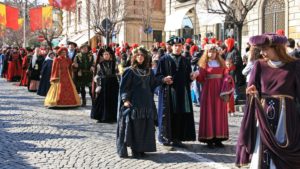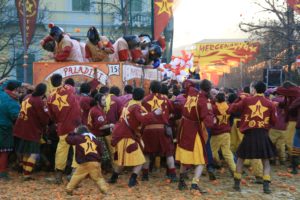Anyone who is planning a trip through Italy during the winter months can’t miss that in this period several Italian cities celebrate Carnival with spectacular events, where everything can happen.
By Alessandra Ivaldi / 5.03.2020
Let’s focus on one of the craziest carnivals of the Italian peninsula. Maybe it’s not one of the most famous carnivals for the tourists arriving from abroad, but it is the most ancient one in Italy – we are talking here about the historic Carnival in Ivrea.
To explain all aspects of this manifestation would not be simple at all. It’s a very important event for the inhabitants of Ivrea and boasts extremely ancient origins. Today this feast consists of a long and complex ritual which includes the organization of different events. The two most important moments of the feast are the parade of figures with historical costumes and the legendary Battle of Oranges.
Let’s start with the parade, during which both inhabitants of Ivrea and visitors can admire a colourful procession marching through the city, led by fife and drum players. In the procession figures representing the most important episodes of Ivrea’s history can be seen.

Photographer: Edoardo Forneris // Flickr
The origins of this feast date back to the 16th century, when the different districts of the town organised, in rivalry with each other, their own manifestation to celebrate Carnival. In this way the town celebrated not one, but many “Carnivals”. At that time the protagonists of the event were the Abbà, a group of cheerful youngsters with the responsibility of representing Ivrea’s different districts. Today, according to the Carnival ritual, each of the five districts has to present two Abbà – who are actually children with Medieval costumes and a little sword as a weapon.
For reasons of public order, Napoleonic authorities, who governed in Ivrea at the beginning of the 1800’s, imposed the unification of these different “Carnivals”. From this very moment another fundamental character for the celebration of Ivrea’s Carnival developed: the General, symbolizing the municipal authority, who wears the uniform of the Napoleonic army during the historical parade.
In the second half of the 19th century, with the spreading of Risorgimental ideals, a new character appeared in the Ivrea’s Carnival ritual. Today this figure is the protagonist of the entire manifestation: the “vezzosa Mugnaia” (the charming miller’s daughter). This character was inspired by the legend of Violetta. She was the daughter of the miller of the town and married someone called Toniotto, but was kidnapped by the minions of the wicked tyrant who reigned in Ivrea. He imprisoned Violetta in his castle, called “Castellazzo”. However, the cunning Violetta managed to get the tyrant drunk and kill him in his sleep, ushering in the uprising of the people against the overbearing local nobility and the destruction of Castellazzo. It’s not easy to establish what the truth behind this legend really is , but the inhabitants of Ivrea are nevertheless very fond of them.
Nowadays the character of the charming Miller Violetta is played by a different woman every year, who must meet the following requirements: she needs to be a citizen of Ivrea and a married woman. In addition, during the parade she must be dressed in white, a symbol of purity and fidelity to her husband. Her dress is decorated with green and red symbols that are reminiscent of the Italian flag.

Photographer: Edoardo Forneris // Flickr
We’ve now become familiar with the main characters of the historical parade, which takes place every day during the Carnival celebrations and which music bands from other Italian regions and from abroad also attend. However, the most spectacular moment is the Battle of the Oranges, which attracts thousands of visitors every year (the only risk being to potentially be hit by some oranges!). But what is this battle all about?
The battle takes place on Sunday, Monday and during Carnival’s Shrove Tuesday and it involves the main squares of the city. There are the tyrant’s troops represented by groups of aranceri (meaning orange throwers) moving aboard horse-drawn wagons, and then there are the people in revolt,the aranceri on foot. The aranceri on the wagons are protected by costumes with flashy paddings and eerie leather masks with iron grates to repair the face. They can throw with both hands in order to intensify the “shooting power”.
Walking bands – made up of hundreds of aranceri, both men and women – rush the wagon, wearing colourful costumes, bells on the ankles and tunics both tied at the waist and half-open at the chest in order to contain abundant supplies of oranges. However, they have no protection at all. Each band has its own name, symbol and colour. Rivalry is not only among people and tyrant’s troops, but also among different aranceri walking bands. A special jury is tasked with observing the battle and, at the end of the three days of fight, awards a prize to the band with the best siege tactic and which demonstrated greater passion and loyalty.

Photographer: Edoardo Forneris // Flickr
As a tribute to the ideals of freedom brought in Piedmont by the French Revolution, during the Carnival, residents and visitors must wear a Phrygian cap, one of the symbols of the Revolution. Those who break this rule run the risk of being targeted by the aranceri!
Since the beginning, the Ivrea’s Battle of the Oranges has given rise to several controversies for the supposed waste of oranges, as well as for the “bollettino dei feriti” (the number of people who report being wounded) with which this crazy celebration ends. However, it is important to note that the oranges launched during the battles, and that cover the streets of the city at the end of each fight, are waste products that would be disposed of anyway.
This is only a preview of the complex rituals of the Ivrea’s Carnival. If you like to know more about this non-ordinary feast, put aside any fear and venture through the streets of Ivrea… but don’t forget your Phrygian cap!




Recent Comments